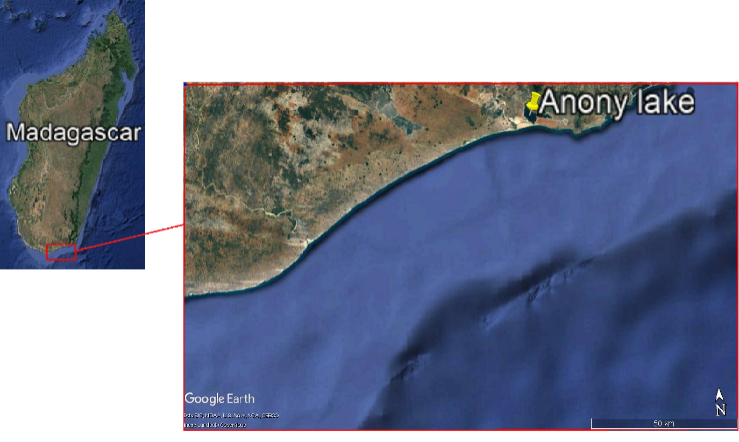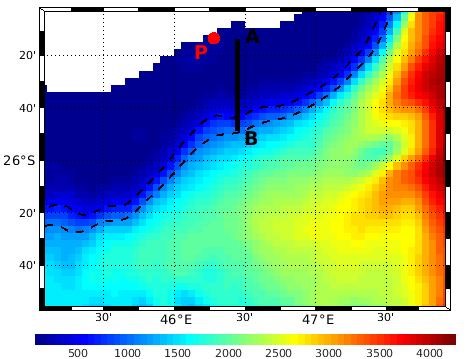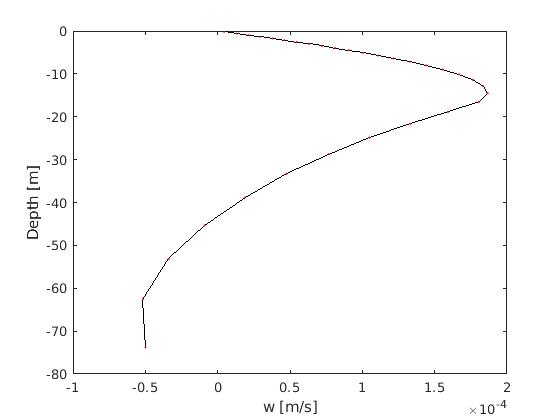-
Paper Information
- Paper Submission
-
Journal Information
- About This Journal
- Editorial Board
- Current Issue
- Archive
- Author Guidelines
- Contact Us
American Journal of Fluid Dynamics
p-ISSN: 2168-4707 e-ISSN: 2168-4715
2020; 10(1): 1-5
doi:10.5923/j.ajfd.20201001.01
Received: Oct. 6, 2020; Accepted: Oct. 23, 2020; Published: Nov. 15, 2020

A Study of Ocean Velocity for Modelling the Upwelling of Seawater around the Anony Lake
Harizo Lahatra Razafindramisa, Nirilanto Miaritiana Rasolozaka, Adolphe A. Ratiarison
Atmosphere Climate and Oceans Dynamics Laboratory (DyACO), University of Antananarivo, Antananarivo, Madagascar
Correspondence to: Harizo Lahatra Razafindramisa, Atmosphere Climate and Oceans Dynamics Laboratory (DyACO), University of Antananarivo, Antananarivo, Madagascar.
| Email: |  |
Copyright © 2020 The Author(s). Published by Scientific & Academic Publishing.
This work is licensed under the Creative Commons Attribution International License (CC BY).
http://creativecommons.org/licenses/by/4.0/

The aim of this work is to study the ocean velocity around the Anony lake in order to test the existence of upwelling in that zone, and to model the phenomenon. The model is created using Regional Ocean Modelling System or ROMS software. We lead a 30 days’ simulation along the geographical coordinates: 25°S-27°S of latitude and 45°E-47°E of longitude, containing 44×59 horizontal grids and 32 vertical grids. The horizontal view of the results shows that both vertical and horizontal components of the velocity represent the existence of the upwelling around the site since vertical velocity is strong and positive and horizontal velocity veers to the coastline. Moreover, in vertical view, according to a section and a grid point, vertical component of velocity shows positive and high value. All these results justify the existence of the upwelling phenomenon in the seawater around the Anony lake.
Keywords: Upwelling, ROMS, Anony lake, Ocean velocity
Cite this paper: Harizo Lahatra Razafindramisa, Nirilanto Miaritiana Rasolozaka, Adolphe A. Ratiarison, A Study of Ocean Velocity for Modelling the Upwelling of Seawater around the Anony Lake, American Journal of Fluid Dynamics, Vol. 10 No. 1, 2020, pp. 1-5. doi: 10.5923/j.ajfd.20201001.01.
Article Outline
1. Introduction
- Anony lake is a salted lake located in south of Am-boasary-Atsimo, in the south-eastern part of Madagascar in the coordinates: 46°29’E of longitude and 25°8’S of latitude. It can witness miscellaneous marine phenomena in the southern basin of the Indian Ocean since the coastline is in direct contact with this part of the ocean (figure 1).
 | Figure 1. Geographical position of Anony lake |
2. Methodology – ROMS Model Implementation
2.1. Dynamical Aspect and Mechanism
- Due to the rotation of the earth, winds tend to turn right in the northern hemisphere and left in the southern hemisphere, technically known as the Coriolis effect. It is as a big part responsible of the upwelling in the coastal region.According to the fundamental principle of dynamics, the motion of an elementary volume of fluid results from the balance of forces exerted on it. Through the Navier-Stokes equations, oceanic flows respond to this principle, while including the rotation of the earth. A major force in the ocean results from pressure variations around a fluid volume. The pressure depends on the density. And this can be inferred from salinity and temperature through a state relationship.Thus, ocean modelling obeys to a system of 7 equations within 7 unknown parameters. Those equations, often called primitive equations, model a particle of sea water in motion. They contain the equation of motion (1,2), the hydrostatic equation (3), the equation of continuity (4), the equation of salt and heat (5,6), and the equation of State of the sea water (7).
 | (1) |
 | (2) |
 | (3) |
 | (4) |
 | (5) |
 | (6) |
 | (7) |
 are the components of the ocean velocity, f the Coriolis parameter,
are the components of the ocean velocity, f the Coriolis parameter,  respectively the horizontal and vertical components of the viscosity and diffusivity coefficient,
respectively the horizontal and vertical components of the viscosity and diffusivity coefficient,  the density of the seawater,
the density of the seawater,  the reference density, g the gravity acceleration, S the salinity of the seawater, T the temperature of the seawater,
the reference density, g the gravity acceleration, S the salinity of the seawater, T the temperature of the seawater,  the reference salinity and
the reference salinity and  the reference temperature.
the reference temperature.2.2. Numerical Methods and Scheme
- ROMS is a numerical model which can run transient simulation for solving geophysical fluid mechanics equations in accordance with Boussinesq-approximation, hydrostatic approximation and incompressibility hypothesis. One of the major advantage of ROMS is that it can perform a discretization both on coastal areas and on terrain with very varied bathymetry. (P. Penven et al., 2010)For solving the above primitive equations with upwelling configuration, given the indeterminacy of the turbulent flow terms, the system of equations requires the addition of so-called "closing" equations. So, horizontal isotropic turbulence and K-profil parametrization scheme (Large et al., 1994) have been adopted with Laplacian Horizontal mixing of momentum scheme.The horizontal discretization of ROMS model implemented here adopt a traditional, centered, second-order finite-difference approximation with the Arakawa C-grid where the flow points
 are calculated in the faces of the mesh (Arakawa and Lamb, 1977). For vertical discretization, a second-order finite-difference approximation is also used but with a σ vertical grid type so as to get a better estimation of the topography. Time-stepping use a split-explicit algorithm and divide the calculation into two modes: barotropic mode and baroclinic mode. Barotropic mode calculation is done between two time-step of the baroclinic mode.
are calculated in the faces of the mesh (Arakawa and Lamb, 1977). For vertical discretization, a second-order finite-difference approximation is also used but with a σ vertical grid type so as to get a better estimation of the topography. Time-stepping use a split-explicit algorithm and divide the calculation into two modes: barotropic mode and baroclinic mode. Barotropic mode calculation is done between two time-step of the baroclinic mode.2.3. Model Implementation
- Using the ocean modelling process of ROMS model, we simulate the ocean motion that may carry out velocity output.We took a study area along the geographical coordinates: 25°S-27°S of latitude and 45°E-47°E. In the simulation, this part of ocean is divided into 59 meridional grids, 44 zonal grids, and 32 levels. The data used for the model include coastline and bathymetry database, lateral and surface forcing database, and climatology database. Those are mostly derived from satellite and in situ records as follow: - GSHHS or Global Self-consistent, Hierarchical, High-resolution Shoreline Database which is a high-resolution shoreline dataset. (source: https://www.ngdc.noaa.gov/mgg/shorelines/gshhs.html).- ETOPO2 for bathymetry, a 2-minute gridded global relief data (source: www.ngdc.noaa/mgg/global/etopo2).- The Atlas of Surface Marine Data (ICOADS) for climatological data. It is monthly climatology (0.5 and 1° resolution) of air-sea parameters derived from individual observations (source: www.ncdc.noaa.gov/oa/climate/coads).- The World Ocean Atlas 2009 (WOA) for forcing, a monthly climatology (1° resolution, 33 vertical levels) of in-situ ocean parameters derived from individual observations (source: www.nodc.noaa.gov/OC5/indprod.html).
3. Simulations of the Ocean Velocity
- Upwelling system can be justified within the characteristics of the sea water dynamics, or its physical aspect (temperature and salinity, density, …). In this paper, we concentrate our study in the dynamics of the sea water represented by the ocean velocity. If sea water rises and moves to the coastal region, it means that the motion is under the lead of positive vertical velocity w, and the vector of horizontal velocity (combination of meridional v, and zonal u components) tend to veer to the coastlines.The model output gives information about the average of each day of simulation. Each day is represented in a time index so that at the end of the simulation, the results contains 30 time indexes or 30 days.The optimal iteration length according to the number of grids and the bathymetry is conforming to a criterion called CFL or Courant-Friedrichs-Levy (Katherine S., 2016):
 | (8) |
3.1. Horizontal Component of the Ocean Velocity
- Firstly, it is important to analyse the horizontal view of the velocity to detect the direction of the horizontal velocity, and the value of vertical velocity. Vertical velocity is positive when seawater rise up and negative when the seawater drops down.In horizontal view, the ocean velocity tends to point in the coastlines. That argument is permanently true during all days of the simulation but the velocity is high around the 29th day (figure 2). Even if in some minor regions the vertical velocity is negative, we can see that in almost all the region of the study area, it shows positive value. We can clearly see the shape of the horizontal vector of the velocity tending to veer in the coast near Anony lake (around 46° 28’. So, in addition to its ascension, the seawater moves to the shoreline.This figure can already be a part of proof that upwelling exists in the study area because it shows strong and positive value of vertical velocity combined with suitable direction of horizontal velocity.
 | Figure 2. Ocean velocity around Anony lake in the 29th day of simulation (vectors represent horizontal velocity; colors represent vertical velocity) |
3.2. Vertical Profile of the Ocean Velocity
- A profile view is taken in a transect (see figure 4) from a point A (of coordinates 46.43°E; 25.21°S) to a point B (of coordinates 46.45°E; 25.83°S) having about 60km of distance (figure 3).
 | Figure 3. Vertical ocean velocity along AB section, day 29 |
3.3. Vertical Profile of the Velocity in a Specific Point around Anony Lake
- Taking a point named P (with the coordinates: 46.39 °E of longitude, 25.18 °S of latitude, see figure 4) in the study area nearby the coastline around Anony lake, the vertical component of the corresponding velocity is given in figure 5.
 | Figure 4. Geographical location of the transect AB and the point P |
 | Figure 5. Vertical profile of the velocity at the point P |
 | Figure 6. Time series of the velocity at the point (46.39 °E; 25.18 °S) |
4. Conclusions
- The study of the ocean velocity can conduct to know where a moving particle can be in a given time. That was the main objective of this paper: to test whether ocean around the Anony lake “wells” or not. The ROMS model implemented in this research is satisfying for it performs good calculation and optimal length of iteration is actually in accordance with grid resolution.Values and directions of the velocity components are suitable for proving the existence of upwelling in the study area. Strong and positive values of vertical velocity have been detected in addition with horizontal velocity vector pointing in the direction of the coastline. There are some days around the day 16 of simulation where vertical velocity is positive and optimal in the chosen point. It can be translated as an upwelling period in that area.Being previously mentioned by other authors (Ramanantsoa et al., 2017), the existence of upwelling phenomenon in the sea around Anony lake is confirmed by the findings of our current research. Anyway, in subsequent works, some parameters such as temperature and salinity may be included to better understand the upwelling in the study area.
 Abstract
Abstract Reference
Reference Full-Text PDF
Full-Text PDF Full-text HTML
Full-text HTML